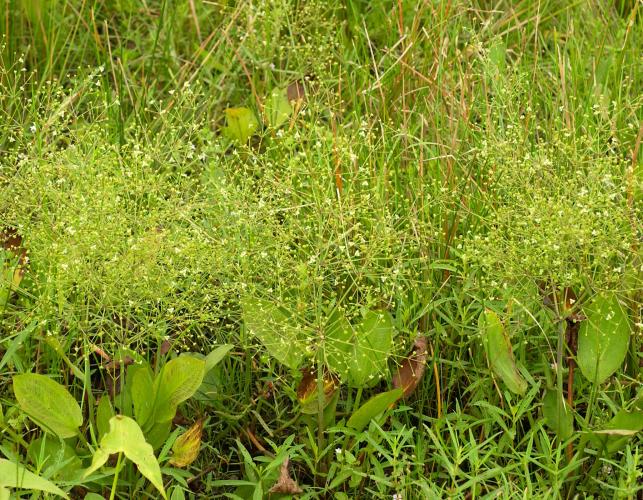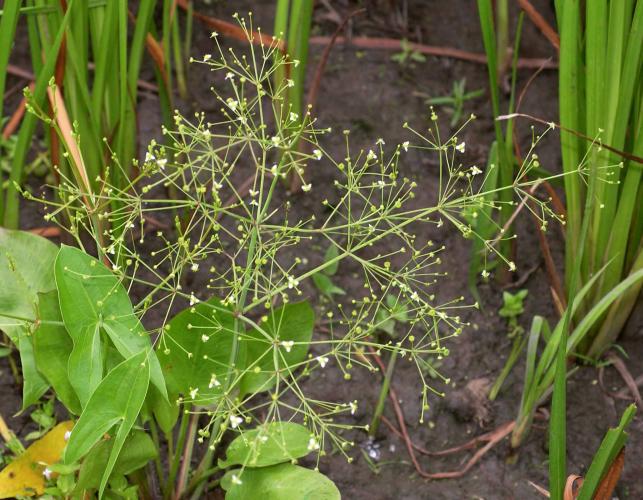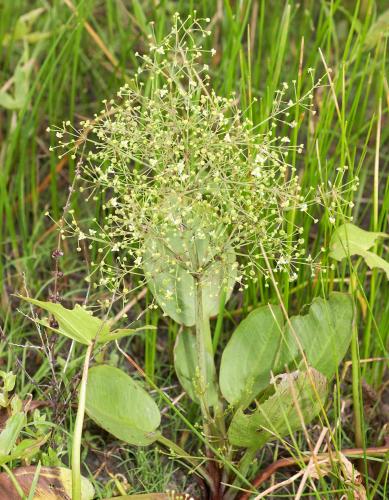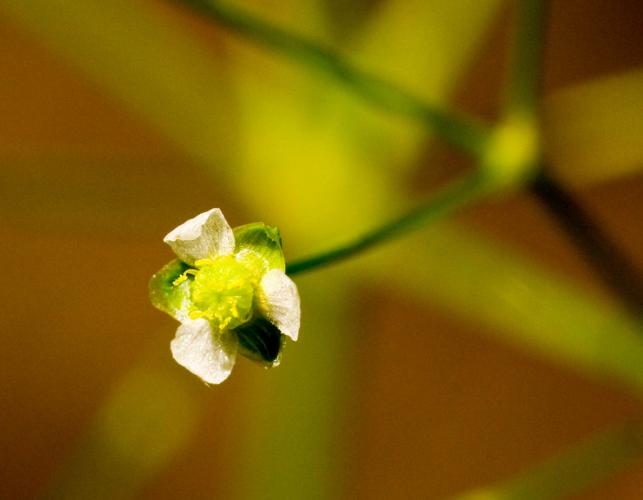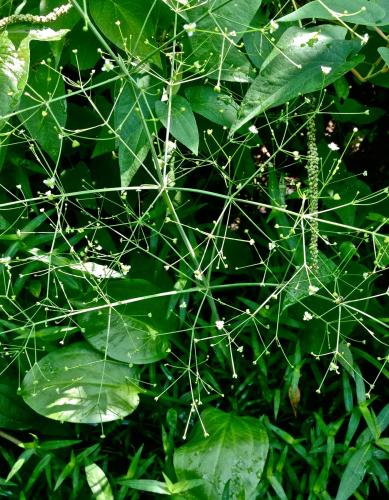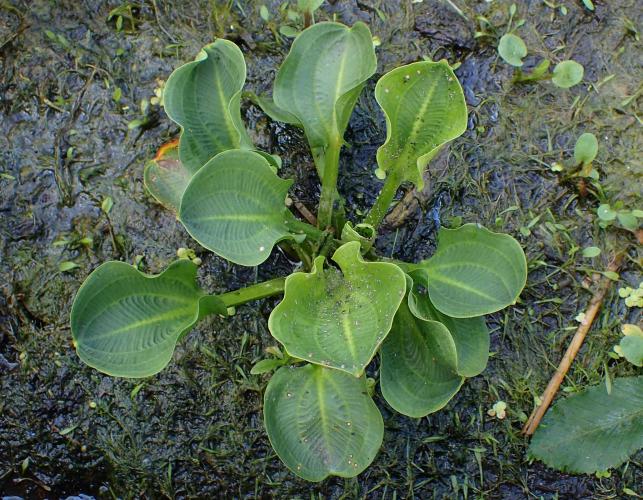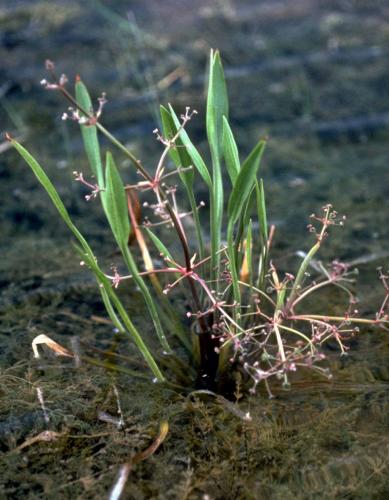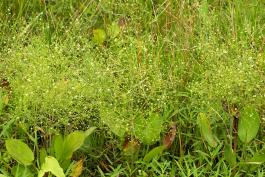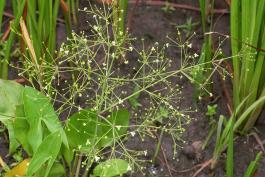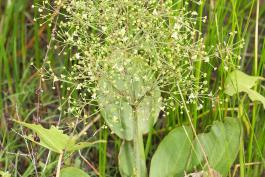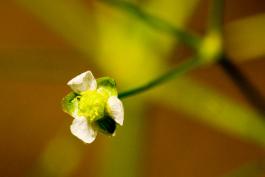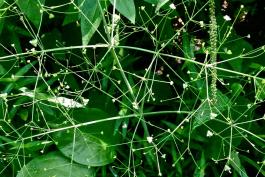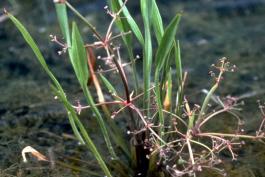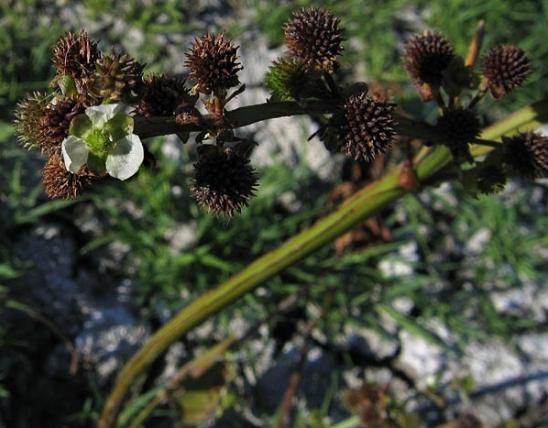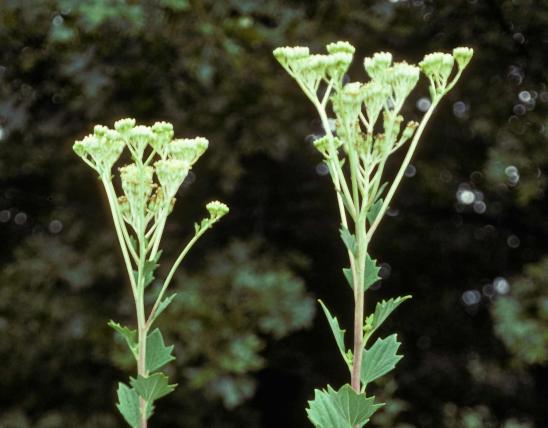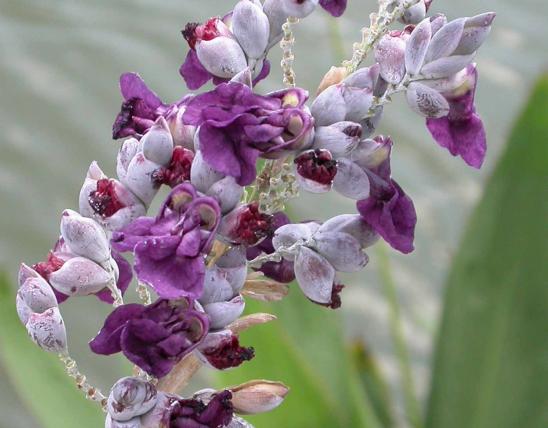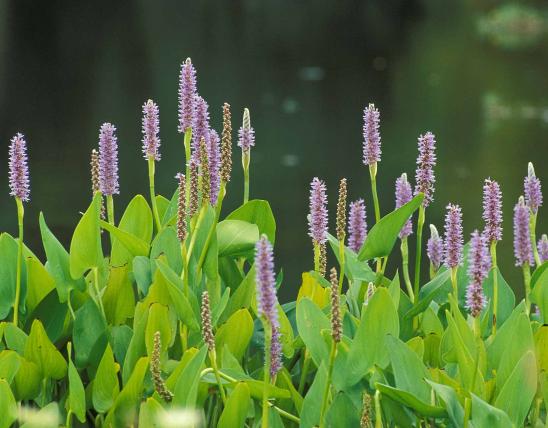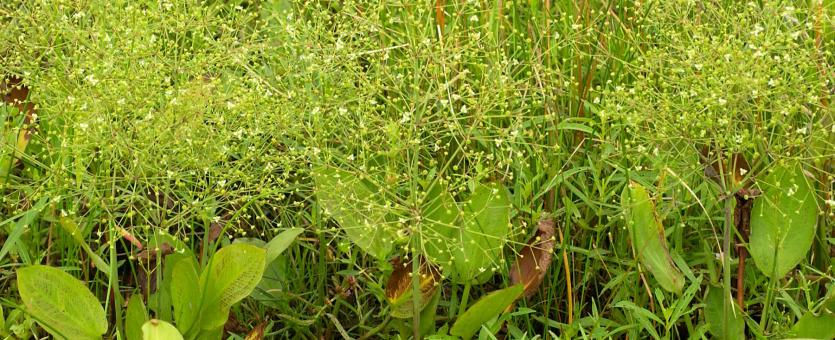
With their whorl of oval leaves with thick, ridged stems, water plantains look like gigantic versions of the plantains that commonly appear unwanted in yards. Water plantains are water-edge plants that bear large, elaborately branching stalks of tiny, white, three-petaled flowers.
Missouri’s water plantains are all perennial plants that grow from rhizomes along shorelines, usually in shallow water. As a group, they have the following characteristics:
- Leaves grow in a basal whorl. Like their close relatives the burheads (Echinodorus spp.), water plantains typically start out with ribbon-shaped, underwater leaves, then develop emergent leaves with well-defined leaf stalks and oval or paddle-shaped leaf blades. The blades have thick, parallel main veins that arise at the stem attachment, arch outward at midleaf, then rejoin at the leaf tip. Numerous smaller, parallel veins run perpendicular to main veins, connecting them.
- Flower stalks are erect, delicate-looking clusters with branches arising in whorls. Flowers are rather tiny, perfect (having both pistils and stamens in the same flower), with bracts at the base in addition to the 3 green sepals. There are 3 petals, which are usually white (sometimes pinkish or purplish tinged). There are 6 stamens. The pistils are in a single ring on the flat receptacle, resulting in a ring of flattened fruits, which lack wings but have 1 or 2 parallel grooves along the back. Blooms in midsummer.
Missouri has three species of water plantains in genus Alisma:
- Northern water plantain (A. triviale) is scattered statewide. It has emergent leaves whose blades are oval to ellipse-shaped with a rounded or heart-shaped base. The leaf stems are rather slender. The leaves, including the stems, are 8–28 inches long. The flower stalks rise high above the leaves and bear many tiny white flowers and small seed heads. In winter, the flowering stalks persist and become hard and woody.
- Southern water plantain (A. subcordatum) is scattered, mostly south of the Missouri River. It is nearly identical to northern water plantain, and the two have sometimes been treated as varieties of the European water plantain A. plantago-aquatica. Distinguishing between northern and southern water plantains involves petal length and diameter of the ring of mature fruits: southern water plantain’s petals are about as long as the sepals, and the diameter of its mature ring of fruits is less than 3.5 mm. In northern water plantain, the petals are longer than the sepals, and the diameter of its mature ring of fruits is 3.5–4.5 mm.
- Grass-leaved water plantain (A. gramineum) is uncommon in southern Missouri, north to Phelps, Pulaski, and Washington counties. It is the oddball of our water plantains. It grows usually as a submerged aquatic, and its leaves are usually thin-textured and grasslike. When its leaves are emergent, they are linear to narrowly ellipse-shaped (3–5 times as long as they are wide), and tapering at the base. The flowers are usually pinkish or purplish-tinged but may be white. In Missouri, this species is more likely to be encountered in cool, fast-flowing waters of Ozark streams and spring branches instead of the muddy soils along slow or still waters.
Similar species: Burheads (Echinodorus spp.) have small, not tiny flowers; less delicate-looking flower clusters; and seed heads that are globe-shaped and covered with spiny seeds (not with seeds in a ring).
Height: 1–3 feet. Varies with species, growing conditions, and time of season.
Statewide. Varies with species.
Habitat and Conservation
Our two most common water plantains are emergent aquatics that grow along the margins of ponds, creeks, sloughs, marshes, and ditches, mostly in mud, usually in shallow water. They may also occur in disturbed soils and a variety of other damp or muddy locations such as spring branches.
Human Connections
The attractive feathery flower stalk, and the plants’ hardy nature make them a natural for water gardening. Because water plantains are rather common, people tend to think of them as undesirable in well-maintained ponds. But water plantains tend to grow singly, don’t spread uncontrollably or crowd out other plants, and remain close to shore. They are attractive, native, and suitable as a border plant around ponds. Just be sure to remove flower heads before the fruits ripen, to prevent young seedlings from becoming a nuisance.
Globally, various species of mud plantains have been used medicinally for treating a number of ailments. One common name for Alisma is “mad-dog weed,” a reference to its past use as a treatment for rabies. Meanwhile, water plantains contain some toxic chemicals and can be dangerous if consumed by people or cattle. The sap irritates the skin of some people. Heating or drying the plants appears to remove the toxicity, and traditional methods of preparation involve cooking and/or drying the plants. Native Americans and other people have eaten the bulbous bases of the plants, harvesting them in late fall or early spring when they contain the greatest amount of starch.
The 19th-century English art critic John Ruskin was intrigued by the mathematical proportions of the ever-decreasing distances between the whorls of branches on the flower stalks. He, and others, have viewed these and other natural geometric patterns (such as the ever-widening spirals of a nautilus shell or the widening spirals in the head of composite flowers) as examples of the so-called golden ratio or divine proportion. Ruskin connected this ratio to his theories about why some types of architecture, painting, and sculpture are aesthetically pleasing to nearly everyone.
Ecosystem Connections
The leaves of water plantain provide shade and shelter for young fish, and marsh birds and songbirds perch on the flower stalks. Geese, ducks, and other waterfowl eat the roots and the nutlike fruits. Muskrat and beaver feed on the roots, leaves, and stems.
